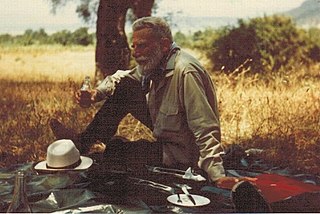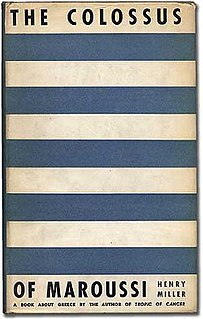
Angela Anaïs Juana Antolina Rosa Edelmira Nin y Culmell, known professionally as Anaïs Nin, was a French-Cuban-American diarist, essayist, novelist and writer of short stories and erotica. Born to Cuban parents in France, Nin was the daughter of composer Joaquín Nin and Rosa Culmell, a classically trained singer. Nin spent her early years in Spain and Cuba, about sixteen years in Paris (1924–1940), and the remaining half of her life in the United States, where she became an established author.

Henry Valentine Miller was an American writer and artist. He was known for breaking with existing literary forms and developing a new type of semi-autobiographical novel that blended character study, social criticism, philosophical reflection, stream of consciousness, explicit language, sex, surrealist free association, and mysticism. His most characteristic works of this kind are Tropic of Cancer, Black Spring, Tropic of Capricorn and The Rosy Crucifixion trilogy, which are based on his experiences in New York and Paris. He also wrote travel memoirs and literary criticism, and painted watercolors.

Lawrence George Durrell was an expatriate British novelist, poet, dramatist, and travel writer. He was the eldest brother of naturalist and writer Gerald Durrell.

Percy Wyndham Lewis was an English writer, painter, and critic. He was a co-founder of the Vorticist movement in art and edited BLAST, the literary magazine of the Vorticists.

David Gascoyne was an English poet associated with the Surrealist movement. He also translated work by French surrealist poets.
Meary James Thurairajah Tambimuttu was a Tamil poet, editor, critic and publisher, who for many years played a significant part on the literary scenes of London and New York City. He founded in 1939 the respected literary magazine Poetry London, which "soon became the best known poetry periodical in England, and Tambimuttu became widely known as a skillful editor." Four issues of Poetry London–New York were published in the 1950s; the fifth in 1960. Among those published by Tambimuttu were Lawrence Durrell, Kathleen Raine, W. H. Auden, Gavin Ewart, Jack Kerouac, Gregory Corso, Allen Ginsberg, Roy Campbell, Robin Skelton, Keith Douglas, and many other notable writers. In 1955 Tambimuttu was described by The New York Times as "probably the best-known contemporary Sri Lankan Tamil poet". He created two publishing houses, Editions Poetry London and Lyrebird Press (1968), both of which published major works.

Tropic of Cancer is a novel by Henry Miller that has been described as "notorious for its candid sexuality" and as responsible for the "free speech that we now take for granted in literature." It was first published in 1934 by the Obelisk Press in Paris, France, but this edition was banned in the United States. Its publication in 1961 in the U.S. by Grove Press led to obscenity trials that tested American laws on pornography in the early 1960s. In 1964, the U.S. Supreme Court declared the book non-obscene. It is regarded as an important work of 20th-century literature.

George Norman Douglas was a British writer, now best known for his 1917 novel South Wind. His travel books, such as Old Calabria (1915), were also appreciated for the quality of their writing.
Hugh Gordon Porteus (1906–1993) was an influential reviewer of art and literature in the London of the 1930s, and also a poet. He was an admirer of Wyndham Lewis and wrote the first critical book on him, published in 1932. Lewis portrayed Porteus as the character "Rotter" Parkinson in his novel Self Condemned.
Alfred Perlès (1897–1990) was an Austrian writer, who was most famous for his associations with Henry Miller, Lawrence Durrell, and Anaïs Nin.

Theodore Philip Stephanides was a Greek-British doctor and polymath, best remembered as the friend and mentor of Gerald Durrell. He was also known as a naturalist, biologist, astronomer, poet, writer and translator.

A mistress is a woman who is in a relatively long-term sexual and romantic relationship with a man who is married to a different woman.

The Revolt of Aphrodite consists of two novels by British writer Lawrence Durrell, published in 1968 and 1970. The individual volumes, Tunc and Nunquam, were less successful than his earlier The Alexandria Quartet, in part because they deviate significantly from his earlier style and because they approach more openly political and ideological problems.
The Avignon Quintet is a five-volume series of novels by British writer Lawrence Durrell, published between 1974 and 1985. The novels are metafictional. He uses developments in experimental fiction that followed his The Alexandria Quartet (1957-1960). The action of the novels is set before and during World War II, largely in France, Egypt, and Switzerland.

Balthazar, published in 1958, is the second volume in The Alexandria Quartet series by British author Lawrence Durrell. Set in Alexandria, Egypt around World War II, the four novels tell essentially the same story from different points of view and come to a conclusion in Clea. Balthazar is the first novel in the series that presents a competing narrator, Balthazar, who writes back to the narrating Darley in his "great interlinear."

Mountolive, published in 1958, is the third volume in The Alexandria Quartet series by British author Lawrence Durrell. Set in Alexandria, Egypt, around World War II, the four novels tell essentially the same story from different points of view and come to a conclusion in Clea.Mountolive is the only third person narrative in the series, and it is also the most overtly political.

Livia, or Buried Alive (1978), is the second volume in British author Lawrence Durrell's The Avignon Quintet, published from 1974 to 1985. Durrell has described the novels as "roped together like climbers on a rockface, but all independent. .. a series of books through which the same characters move for all the world as if to illustrate the notion of reincarnation." The description of this form for the quintet actually appears in Livia. The first novel of the quincunx, Monsieur, received the James Tait Black Memorial Prize in 1974.

Constance, or Solitary Practices (1982) is the central volume of the five novels of Lawrence Durrell's The Avignon Quintet, published from 1974 to 1985. It was nominated for the Booker Prize in 1982. Involving some of the characters from the preceding Livia, the novel also introduces new ones. It is set before and during World War II, in France, Egypt, Poland and Switzerland.

The Colossus of Maroussi is an impressionist travelogue by American writer Henry Miller that was first published in 1941 by Colt Press of San Francisco. Set in pre-war Greece of 1939, it is ostensibly an exploration of the "Colossus" of the title, George Katsimbalis, a poet and raconteur. The work is frequently heralded as Miller's best.
Richard Leslie Beswetherick Pine is the author of critical works on the Irish playwright Brian Friel, the Anglo-Irish novelist Lawrence Durrell, and aspects of art music in Ireland. He worked for the Irish national broadcaster RTÉ Raidió Teilifís Éireann before moving to Greece in 2001 to found the Durrell School of Corfu, which he directed until 2010. In 2012, to mark the centenary of the birth of Lawrence Durrell, Pine edited and introduced a previously unpublished novel by Durrell, Judith, set in 1940s Palestine. From 2009 to 2020 he wrote a regular column on Greek affairs in The Irish Times and was also an obituarist for The Guardian. Lawrence Durrell described Pine's work as "the best unpacking of my literary baggage I have heard."















